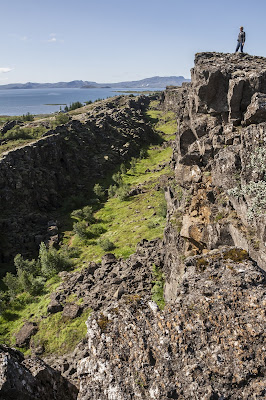Norway is a country we had been looking forward to visiting for a very long time and during our planning for this trip, you quickly understand it is also a very expensive destination, even more so than Denmark.
As a result we decided to use various forms of transport to get to and around Norway, hence the ferry from Hirtshals in Denmark, but we also used trains, buses, boats and planes and the map below shows our entire journey through Norway.
 |
| Boats, trains, buses and planes through Norway |
 |
| Coastal ferry trips from Denmark to Bergen, Norway |
 |
| Pulpit Rock, Norway |
The first ferry from Denmark to Stavanger was a fabulous way of seeing some of the beautiful coastline of Norway, the scenery very different from the flat form of Denmark.
Whilst in Stavanger, we took a bus to go on a hike, a 3hr hike... actually more like a climb and fortunately in clear and warm weather, as our destination called Preikestolen is renowned for being in fog or clouds frequently.
Whilst at times this was a reasonably tough hike clambering over rocks, the final result was well worth it.
Preikestolen, also known as the Pulpit Rock, in Ryfylke in Rogaland is a flat plateau of about 25 by 25 metres, which rises 604 metres straight up from the Lysefjord fjord.
From here, the rock disappears vertically below you and if you sit right on the edge there are fantastic views of the waters below and the Lysefjordheiene mountains.
 |
| Admiring the view from Pulpit Rock |
 |
| View down the fjord from Pulpit Rock |
After another very interesting coastal commuter ferry trip stopping at multiple small towns, we arrived into Bergen founded about 900 years ago during the viking era.
 |
| Coastal town on the way to Bergen |
There is much to see and do in and around Bergen, which also enjoys a vibrant atmosphere. This very urban city of ~280,000 is one of Norway's most visited destinations because of its own scenery as well as its proximity to some of Norway's largest fjords.
 |
| View of the city centre from Mt. Fløyen |
One of the city's most visited areas is the World Heritage area of Bryggen, an old town section with many brightly coloured timber buildings used in the past for trading. Most of the buildings over the years have been destroyed by fire and rebuilt.
 |
| View of historic Bryggen back to Mt. Fløyen |
But the nearby fjords beckoned, so with luggage in tow we took a boat tour to view the fjords before catching the famous Flam railway towards Oslo.
 |
| Water level view of the Norwegian fjords |
We didn't spend much time in Oslo, not because it isn't a nice city, but simply because we were about to head into the arctic circle to stay on a small chain of islands we learned about from a Norwegian work colleague called the Lofoten archipelago.
 |
| The VERY beautiful Lofoten archipelago |
After flying into Svolvær, we picked up our 'rent a wreck' and went searching for the accomodation called a rorbu, which were originally huts used by cod fisherman venturing into this region of the Norwegian coast.
Rorbuer (plural) are all painted red, are quite small with low roofs and ceilings but were very comfortable, cosy and quaint.
 |
| Around Svolvaer and the bright red rorbuer |
This place is just amazing from a scenery point of view, with towering jagged mountains right next to the ocean, small islands visible everywhere and incredibly clear seawater supporting the growth of not just the fish but the seaweed and shell fish covering the rocky shores as far as you can see.
Our rent a wreck actually got a lot of use because you can drive the complete length of the island chain and the scenery everywhere was just breathtaking and this part of the world soon reached one of our very few - 'must visit again' destinations!
 |
| Near the southern end of Lofotens in small town simply called Å |
 |
| Cod drying on racks |
 |
| More of Lofoten's stunning scenery |
I could go on and on about this part of Norway because of its beauty, but time for another boat trip, this time overnight, further north up the coast on a ferry called the Hurtigruten cruise line. These are big, comfortable ships which travel the entire length of the coastline carrying tourists, cars and goods for local communities.
 |
| Hurtigruten ship at Lofoten Islands |
From the map you can see where we had been and where this vessel took us, Tromso, 350kms north of the Arctic Circle and near the very top of Norway and as a result, significantly colder than anywhere we had been so far.
 |
| The route to Tromso, well into the Arctic Circle |
Tromso is a small city with a population of ~50,000, including a large proportion of younger people attending universities in the area.
 |
| View of Tromso from Storsteinen mountain ledge |
It was in Tromso we discovered just how expensive Norway could be when we went searching for dinner. The prices on menus outside a few restaurants were simply crazy, so we had a look at a burger place similar to Hungry Jacks and the total for 2 meal deals was $60 AUD.
But we weren't in Tromso to spend too much time here, it had been the end of the rest of a wonderful trip through Norway and where we needed to catch a plane to the most northern city in the world, to then join an expedition boat for our next adventure.
So until our next post.... go well!






















































